Finnegan Constructions: GRI Sustainability Report Analysis
VerifiedAdded on 2022/08/12
|12
|2924
|24
Report
AI Summary
This report examines the governance, ethics, and sustainability practices of Finnegan Constructions, a residential development company. It analyzes the company's actions across economic, environmental, and social dimensions, referencing GRI Sustainability Reports. The analysis covers economic aspects like costs associated with climate change adaptation and ethical breaches involving bribery and anti-competitive behavior. Environmental sustainability is assessed through energy consumption, impact on biodiversity, and environmental damage. Social sustainability is examined through labor market dynamics, employee retention, and workplace ethics, including age-related discrimination. The report highlights areas where Finnegan Constructions demonstrates strengths and weaknesses in its sustainability efforts, providing insights into its overall corporate responsibility.
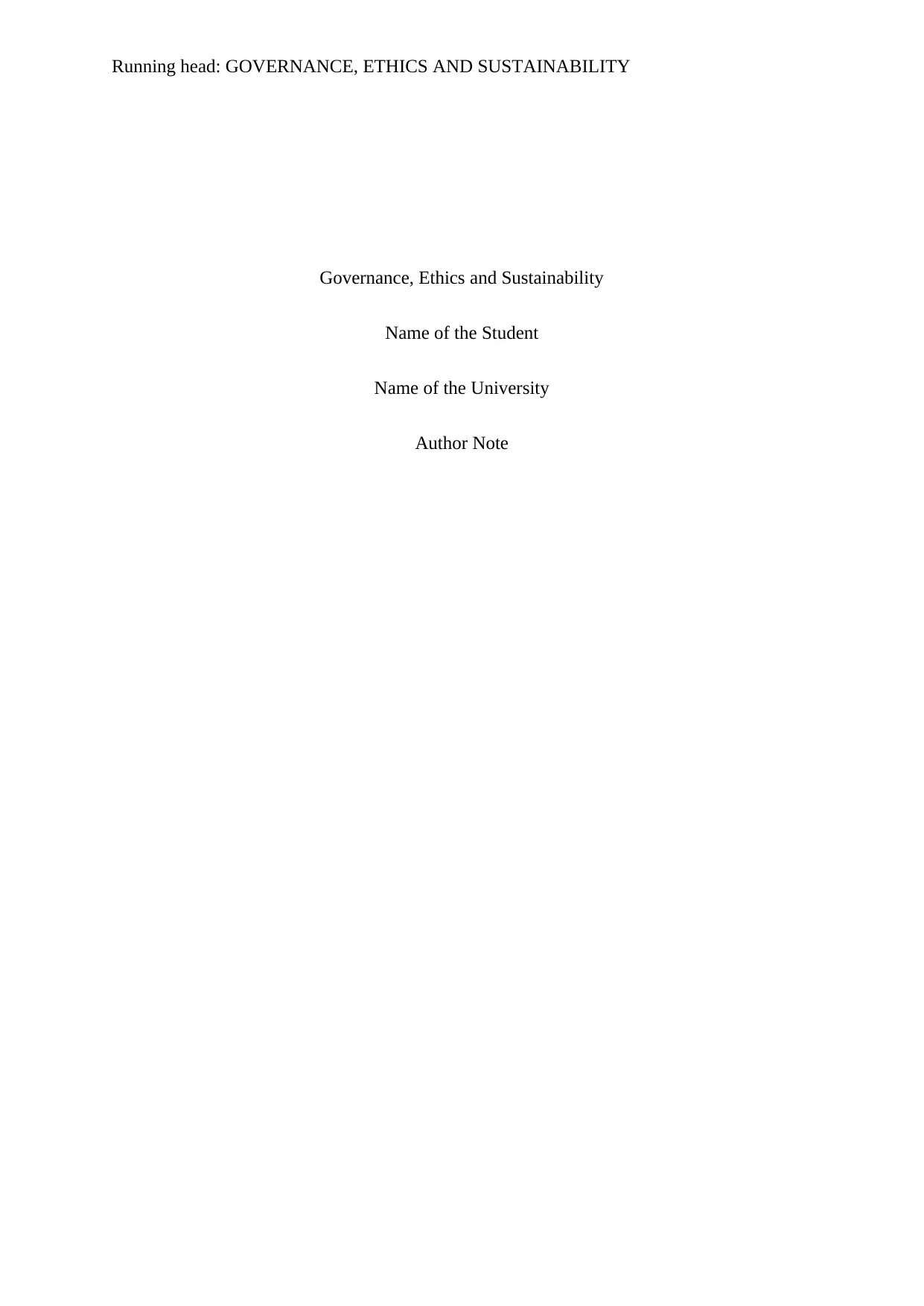
Running head: GOVERNANCE, ETHICS AND SUSTAINABILITY
Governance, Ethics and Sustainability
Name of the Student
Name of the University
Author Note
Governance, Ethics and Sustainability
Name of the Student
Name of the University
Author Note
Paraphrase This Document
Need a fresh take? Get an instant paraphrase of this document with our AI Paraphraser
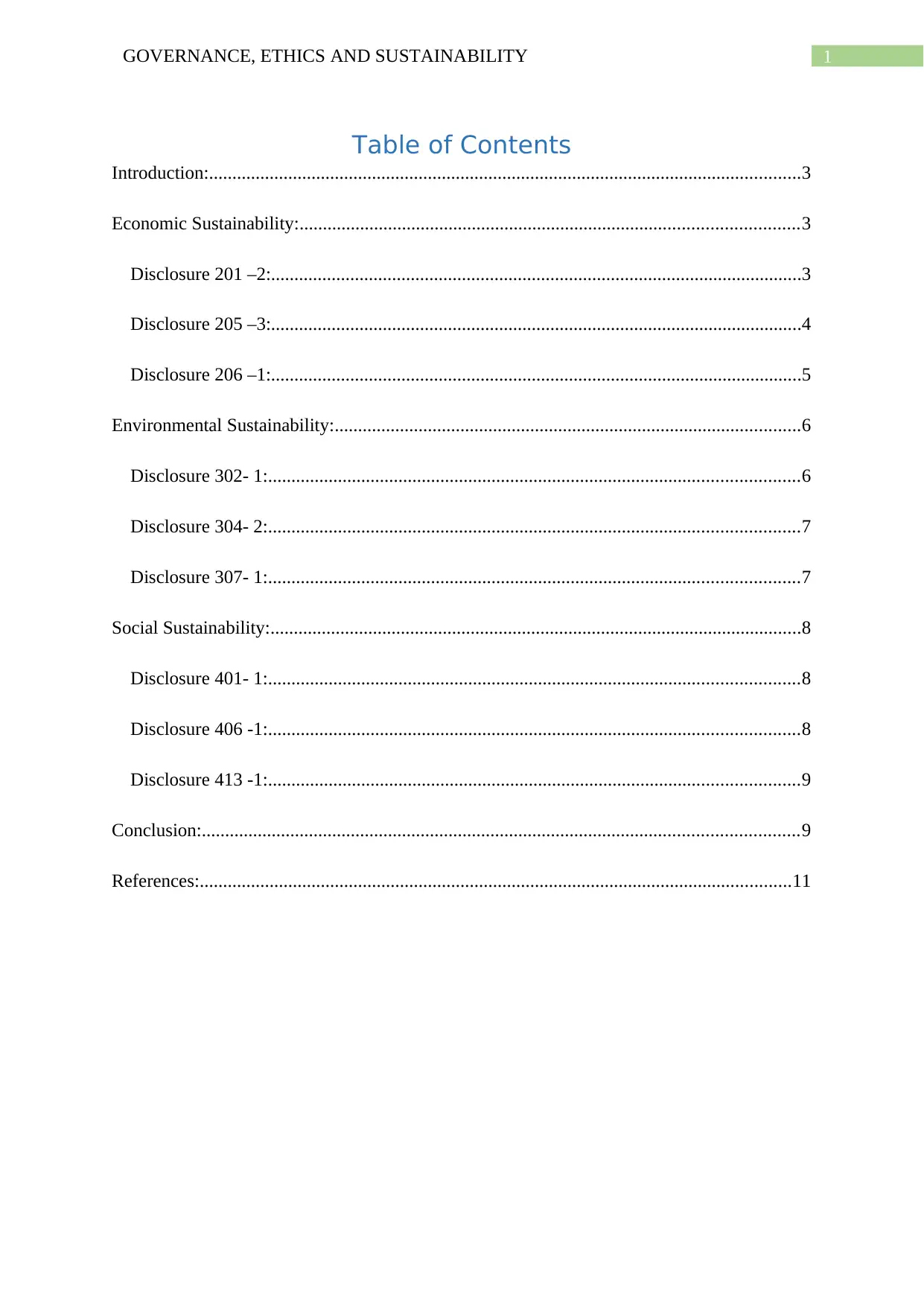
1GOVERNANCE, ETHICS AND SUSTAINABILITY
Table of Contents
Introduction:...............................................................................................................................3
Economic Sustainability:...........................................................................................................3
Disclosure 201 –2:..................................................................................................................3
Disclosure 205 –3:..................................................................................................................4
Disclosure 206 –1:..................................................................................................................5
Environmental Sustainability:....................................................................................................6
Disclosure 302- 1:..................................................................................................................6
Disclosure 304- 2:..................................................................................................................7
Disclosure 307- 1:..................................................................................................................7
Social Sustainability:..................................................................................................................8
Disclosure 401- 1:..................................................................................................................8
Disclosure 406 -1:..................................................................................................................8
Disclosure 413 -1:..................................................................................................................9
Conclusion:................................................................................................................................9
References:...............................................................................................................................11
Table of Contents
Introduction:...............................................................................................................................3
Economic Sustainability:...........................................................................................................3
Disclosure 201 –2:..................................................................................................................3
Disclosure 205 –3:..................................................................................................................4
Disclosure 206 –1:..................................................................................................................5
Environmental Sustainability:....................................................................................................6
Disclosure 302- 1:..................................................................................................................6
Disclosure 304- 2:..................................................................................................................7
Disclosure 307- 1:..................................................................................................................7
Social Sustainability:..................................................................................................................8
Disclosure 401- 1:..................................................................................................................8
Disclosure 406 -1:..................................................................................................................8
Disclosure 413 -1:..................................................................................................................9
Conclusion:................................................................................................................................9
References:...............................................................................................................................11
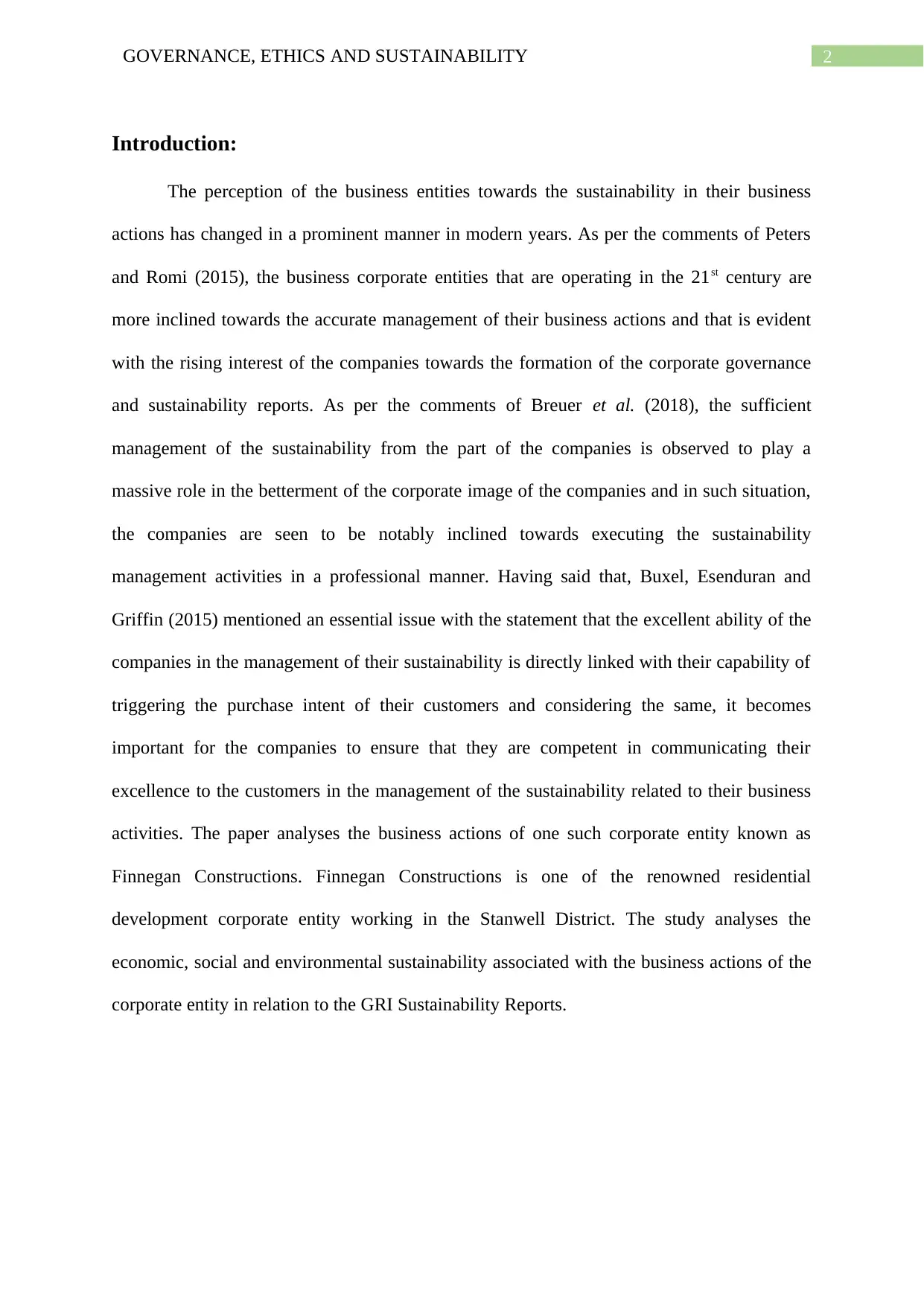
2GOVERNANCE, ETHICS AND SUSTAINABILITY
Introduction:
The perception of the business entities towards the sustainability in their business
actions has changed in a prominent manner in modern years. As per the comments of Peters
and Romi (2015), the business corporate entities that are operating in the 21st century are
more inclined towards the accurate management of their business actions and that is evident
with the rising interest of the companies towards the formation of the corporate governance
and sustainability reports. As per the comments of Breuer et al. (2018), the sufficient
management of the sustainability from the part of the companies is observed to play a
massive role in the betterment of the corporate image of the companies and in such situation,
the companies are seen to be notably inclined towards executing the sustainability
management activities in a professional manner. Having said that, Buxel, Esenduran and
Griffin (2015) mentioned an essential issue with the statement that the excellent ability of the
companies in the management of their sustainability is directly linked with their capability of
triggering the purchase intent of their customers and considering the same, it becomes
important for the companies to ensure that they are competent in communicating their
excellence to the customers in the management of the sustainability related to their business
activities. The paper analyses the business actions of one such corporate entity known as
Finnegan Constructions. Finnegan Constructions is one of the renowned residential
development corporate entity working in the Stanwell District. The study analyses the
economic, social and environmental sustainability associated with the business actions of the
corporate entity in relation to the GRI Sustainability Reports.
Introduction:
The perception of the business entities towards the sustainability in their business
actions has changed in a prominent manner in modern years. As per the comments of Peters
and Romi (2015), the business corporate entities that are operating in the 21st century are
more inclined towards the accurate management of their business actions and that is evident
with the rising interest of the companies towards the formation of the corporate governance
and sustainability reports. As per the comments of Breuer et al. (2018), the sufficient
management of the sustainability from the part of the companies is observed to play a
massive role in the betterment of the corporate image of the companies and in such situation,
the companies are seen to be notably inclined towards executing the sustainability
management activities in a professional manner. Having said that, Buxel, Esenduran and
Griffin (2015) mentioned an essential issue with the statement that the excellent ability of the
companies in the management of their sustainability is directly linked with their capability of
triggering the purchase intent of their customers and considering the same, it becomes
important for the companies to ensure that they are competent in communicating their
excellence to the customers in the management of the sustainability related to their business
activities. The paper analyses the business actions of one such corporate entity known as
Finnegan Constructions. Finnegan Constructions is one of the renowned residential
development corporate entity working in the Stanwell District. The study analyses the
economic, social and environmental sustainability associated with the business actions of the
corporate entity in relation to the GRI Sustainability Reports.
⊘ This is a preview!⊘
Do you want full access?
Subscribe today to unlock all pages.

Trusted by 1+ million students worldwide
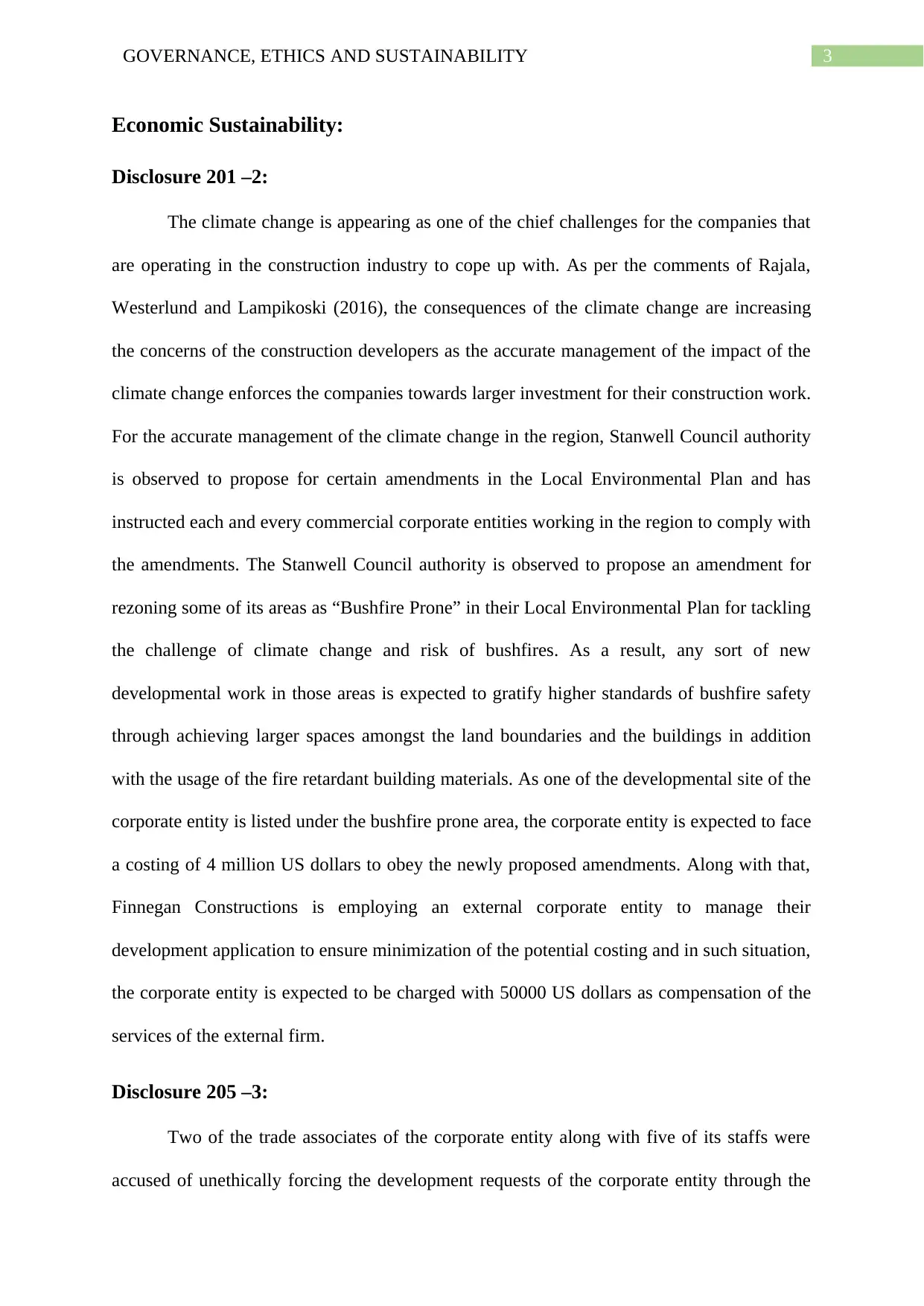
3GOVERNANCE, ETHICS AND SUSTAINABILITY
Economic Sustainability:
Disclosure 201 –2:
The climate change is appearing as one of the chief challenges for the companies that
are operating in the construction industry to cope up with. As per the comments of Rajala,
Westerlund and Lampikoski (2016), the consequences of the climate change are increasing
the concerns of the construction developers as the accurate management of the impact of the
climate change enforces the companies towards larger investment for their construction work.
For the accurate management of the climate change in the region, Stanwell Council authority
is observed to propose for certain amendments in the Local Environmental Plan and has
instructed each and every commercial corporate entities working in the region to comply with
the amendments. The Stanwell Council authority is observed to propose an amendment for
rezoning some of its areas as “Bushfire Prone” in their Local Environmental Plan for tackling
the challenge of climate change and risk of bushfires. As a result, any sort of new
developmental work in those areas is expected to gratify higher standards of bushfire safety
through achieving larger spaces amongst the land boundaries and the buildings in addition
with the usage of the fire retardant building materials. As one of the developmental site of the
corporate entity is listed under the bushfire prone area, the corporate entity is expected to face
a costing of 4 million US dollars to obey the newly proposed amendments. Along with that,
Finnegan Constructions is employing an external corporate entity to manage their
development application to ensure minimization of the potential costing and in such situation,
the corporate entity is expected to be charged with 50000 US dollars as compensation of the
services of the external firm.
Disclosure 205 –3:
Two of the trade associates of the corporate entity along with five of its staffs were
accused of unethically forcing the development requests of the corporate entity through the
Economic Sustainability:
Disclosure 201 –2:
The climate change is appearing as one of the chief challenges for the companies that
are operating in the construction industry to cope up with. As per the comments of Rajala,
Westerlund and Lampikoski (2016), the consequences of the climate change are increasing
the concerns of the construction developers as the accurate management of the impact of the
climate change enforces the companies towards larger investment for their construction work.
For the accurate management of the climate change in the region, Stanwell Council authority
is observed to propose for certain amendments in the Local Environmental Plan and has
instructed each and every commercial corporate entities working in the region to comply with
the amendments. The Stanwell Council authority is observed to propose an amendment for
rezoning some of its areas as “Bushfire Prone” in their Local Environmental Plan for tackling
the challenge of climate change and risk of bushfires. As a result, any sort of new
developmental work in those areas is expected to gratify higher standards of bushfire safety
through achieving larger spaces amongst the land boundaries and the buildings in addition
with the usage of the fire retardant building materials. As one of the developmental site of the
corporate entity is listed under the bushfire prone area, the corporate entity is expected to face
a costing of 4 million US dollars to obey the newly proposed amendments. Along with that,
Finnegan Constructions is employing an external corporate entity to manage their
development application to ensure minimization of the potential costing and in such situation,
the corporate entity is expected to be charged with 50000 US dollars as compensation of the
services of the external firm.
Disclosure 205 –3:
Two of the trade associates of the corporate entity along with five of its staffs were
accused of unethically forcing the development requests of the corporate entity through the
Paraphrase This Document
Need a fresh take? Get an instant paraphrase of this document with our AI Paraphraser
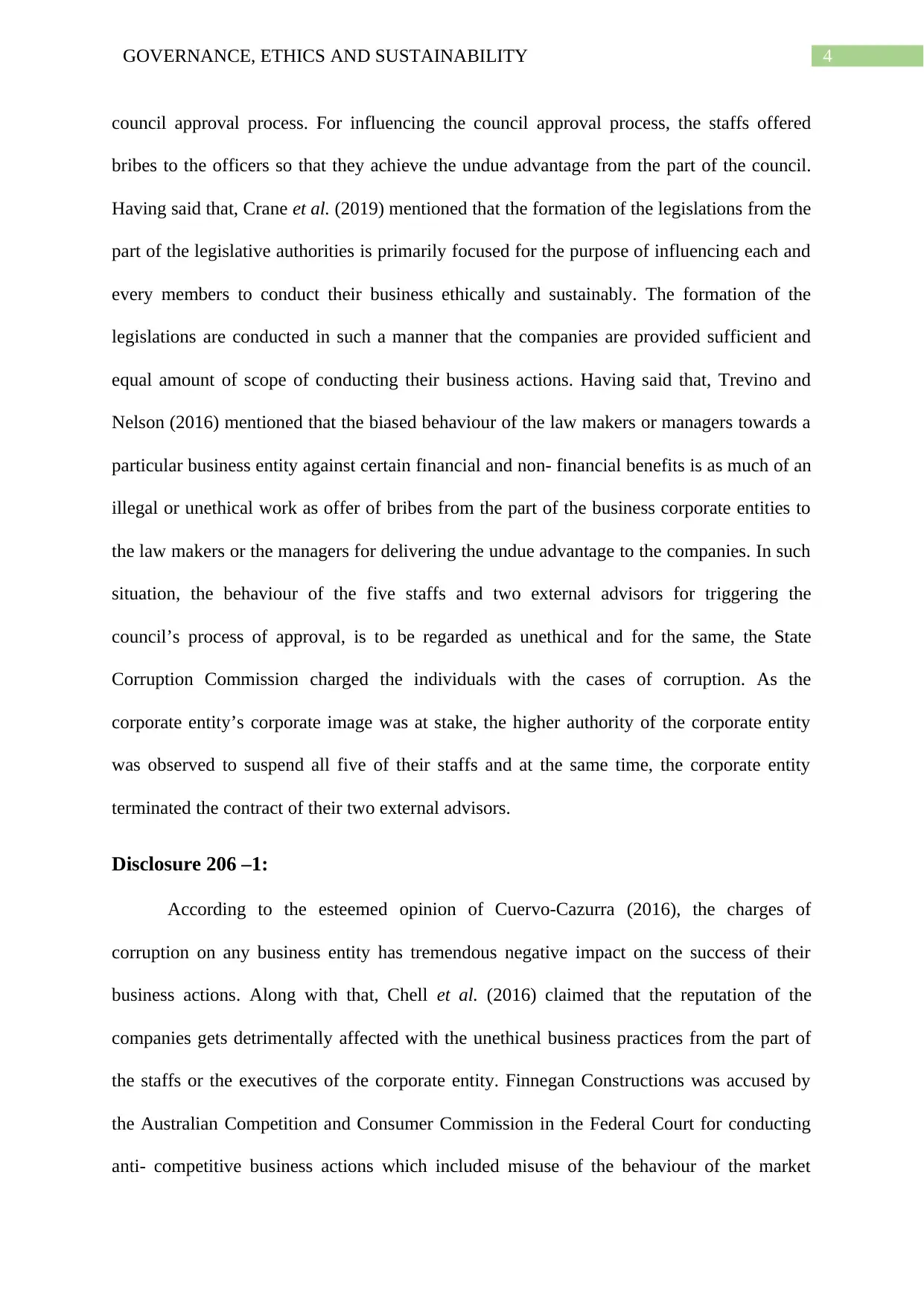
4GOVERNANCE, ETHICS AND SUSTAINABILITY
council approval process. For influencing the council approval process, the staffs offered
bribes to the officers so that they achieve the undue advantage from the part of the council.
Having said that, Crane et al. (2019) mentioned that the formation of the legislations from the
part of the legislative authorities is primarily focused for the purpose of influencing each and
every members to conduct their business ethically and sustainably. The formation of the
legislations are conducted in such a manner that the companies are provided sufficient and
equal amount of scope of conducting their business actions. Having said that, Trevino and
Nelson (2016) mentioned that the biased behaviour of the law makers or managers towards a
particular business entity against certain financial and non- financial benefits is as much of an
illegal or unethical work as offer of bribes from the part of the business corporate entities to
the law makers or the managers for delivering the undue advantage to the companies. In such
situation, the behaviour of the five staffs and two external advisors for triggering the
council’s process of approval, is to be regarded as unethical and for the same, the State
Corruption Commission charged the individuals with the cases of corruption. As the
corporate entity’s corporate image was at stake, the higher authority of the corporate entity
was observed to suspend all five of their staffs and at the same time, the corporate entity
terminated the contract of their two external advisors.
Disclosure 206 –1:
According to the esteemed opinion of Cuervo-Cazurra (2016), the charges of
corruption on any business entity has tremendous negative impact on the success of their
business actions. Along with that, Chell et al. (2016) claimed that the reputation of the
companies gets detrimentally affected with the unethical business practices from the part of
the staffs or the executives of the corporate entity. Finnegan Constructions was accused by
the Australian Competition and Consumer Commission in the Federal Court for conducting
anti- competitive business actions which included misuse of the behaviour of the market
council approval process. For influencing the council approval process, the staffs offered
bribes to the officers so that they achieve the undue advantage from the part of the council.
Having said that, Crane et al. (2019) mentioned that the formation of the legislations from the
part of the legislative authorities is primarily focused for the purpose of influencing each and
every members to conduct their business ethically and sustainably. The formation of the
legislations are conducted in such a manner that the companies are provided sufficient and
equal amount of scope of conducting their business actions. Having said that, Trevino and
Nelson (2016) mentioned that the biased behaviour of the law makers or managers towards a
particular business entity against certain financial and non- financial benefits is as much of an
illegal or unethical work as offer of bribes from the part of the business corporate entities to
the law makers or the managers for delivering the undue advantage to the companies. In such
situation, the behaviour of the five staffs and two external advisors for triggering the
council’s process of approval, is to be regarded as unethical and for the same, the State
Corruption Commission charged the individuals with the cases of corruption. As the
corporate entity’s corporate image was at stake, the higher authority of the corporate entity
was observed to suspend all five of their staffs and at the same time, the corporate entity
terminated the contract of their two external advisors.
Disclosure 206 –1:
According to the esteemed opinion of Cuervo-Cazurra (2016), the charges of
corruption on any business entity has tremendous negative impact on the success of their
business actions. Along with that, Chell et al. (2016) claimed that the reputation of the
companies gets detrimentally affected with the unethical business practices from the part of
the staffs or the executives of the corporate entity. Finnegan Constructions was accused by
the Australian Competition and Consumer Commission in the Federal Court for conducting
anti- competitive business actions which included misuse of the behaviour of the market
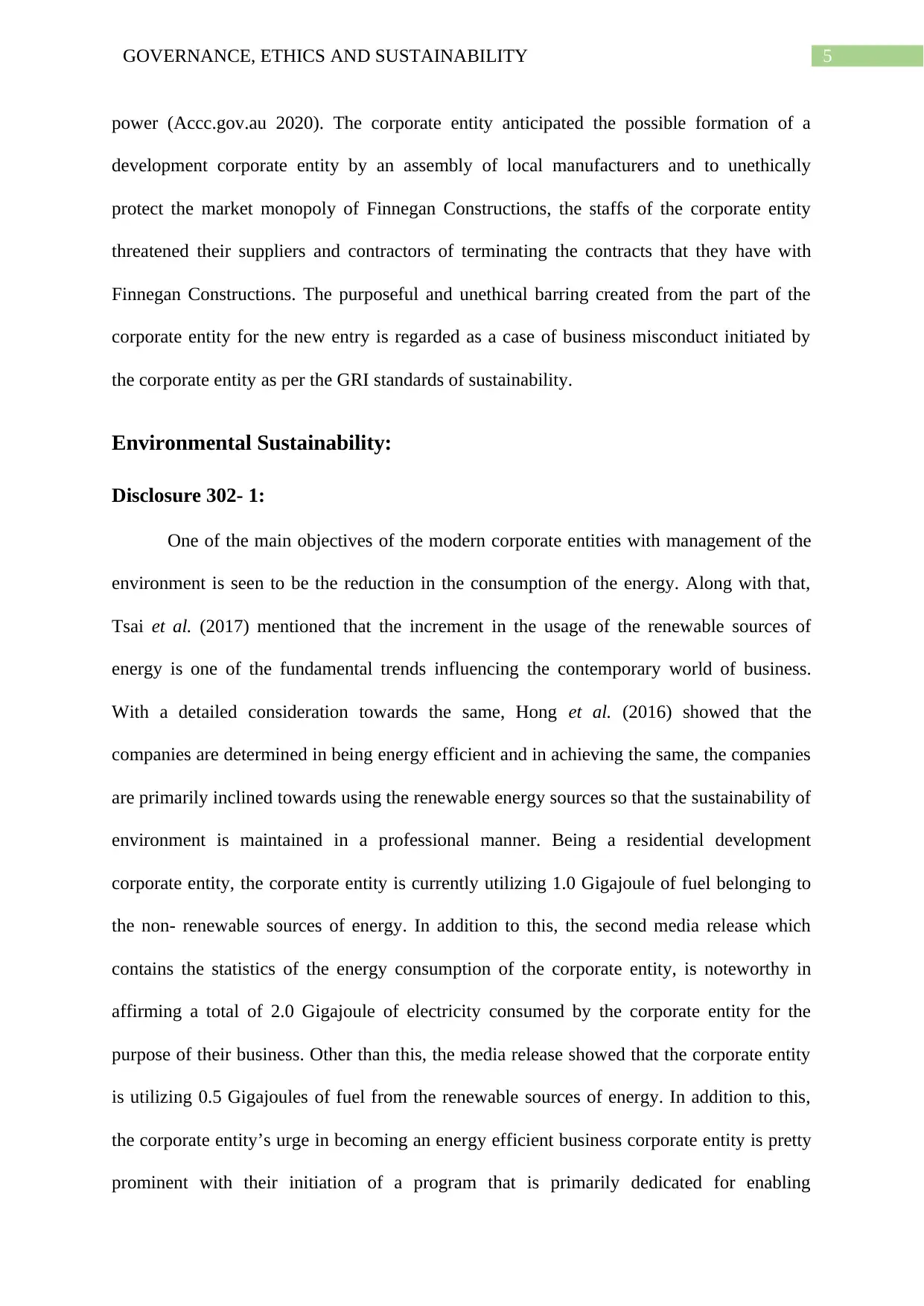
5GOVERNANCE, ETHICS AND SUSTAINABILITY
power (Accc.gov.au 2020). The corporate entity anticipated the possible formation of a
development corporate entity by an assembly of local manufacturers and to unethically
protect the market monopoly of Finnegan Constructions, the staffs of the corporate entity
threatened their suppliers and contractors of terminating the contracts that they have with
Finnegan Constructions. The purposeful and unethical barring created from the part of the
corporate entity for the new entry is regarded as a case of business misconduct initiated by
the corporate entity as per the GRI standards of sustainability.
Environmental Sustainability:
Disclosure 302- 1:
One of the main objectives of the modern corporate entities with management of the
environment is seen to be the reduction in the consumption of the energy. Along with that,
Tsai et al. (2017) mentioned that the increment in the usage of the renewable sources of
energy is one of the fundamental trends influencing the contemporary world of business.
With a detailed consideration towards the same, Hong et al. (2016) showed that the
companies are determined in being energy efficient and in achieving the same, the companies
are primarily inclined towards using the renewable energy sources so that the sustainability of
environment is maintained in a professional manner. Being a residential development
corporate entity, the corporate entity is currently utilizing 1.0 Gigajoule of fuel belonging to
the non- renewable sources of energy. In addition to this, the second media release which
contains the statistics of the energy consumption of the corporate entity, is noteworthy in
affirming a total of 2.0 Gigajoule of electricity consumed by the corporate entity for the
purpose of their business. Other than this, the media release showed that the corporate entity
is utilizing 0.5 Gigajoules of fuel from the renewable sources of energy. In addition to this,
the corporate entity’s urge in becoming an energy efficient business corporate entity is pretty
prominent with their initiation of a program that is primarily dedicated for enabling
power (Accc.gov.au 2020). The corporate entity anticipated the possible formation of a
development corporate entity by an assembly of local manufacturers and to unethically
protect the market monopoly of Finnegan Constructions, the staffs of the corporate entity
threatened their suppliers and contractors of terminating the contracts that they have with
Finnegan Constructions. The purposeful and unethical barring created from the part of the
corporate entity for the new entry is regarded as a case of business misconduct initiated by
the corporate entity as per the GRI standards of sustainability.
Environmental Sustainability:
Disclosure 302- 1:
One of the main objectives of the modern corporate entities with management of the
environment is seen to be the reduction in the consumption of the energy. Along with that,
Tsai et al. (2017) mentioned that the increment in the usage of the renewable sources of
energy is one of the fundamental trends influencing the contemporary world of business.
With a detailed consideration towards the same, Hong et al. (2016) showed that the
companies are determined in being energy efficient and in achieving the same, the companies
are primarily inclined towards using the renewable energy sources so that the sustainability of
environment is maintained in a professional manner. Being a residential development
corporate entity, the corporate entity is currently utilizing 1.0 Gigajoule of fuel belonging to
the non- renewable sources of energy. In addition to this, the second media release which
contains the statistics of the energy consumption of the corporate entity, is noteworthy in
affirming a total of 2.0 Gigajoule of electricity consumed by the corporate entity for the
purpose of their business. Other than this, the media release showed that the corporate entity
is utilizing 0.5 Gigajoules of fuel from the renewable sources of energy. In addition to this,
the corporate entity’s urge in becoming an energy efficient business corporate entity is pretty
prominent with their initiation of a program that is primarily dedicated for enabling
⊘ This is a preview!⊘
Do you want full access?
Subscribe today to unlock all pages.

Trusted by 1+ million students worldwide
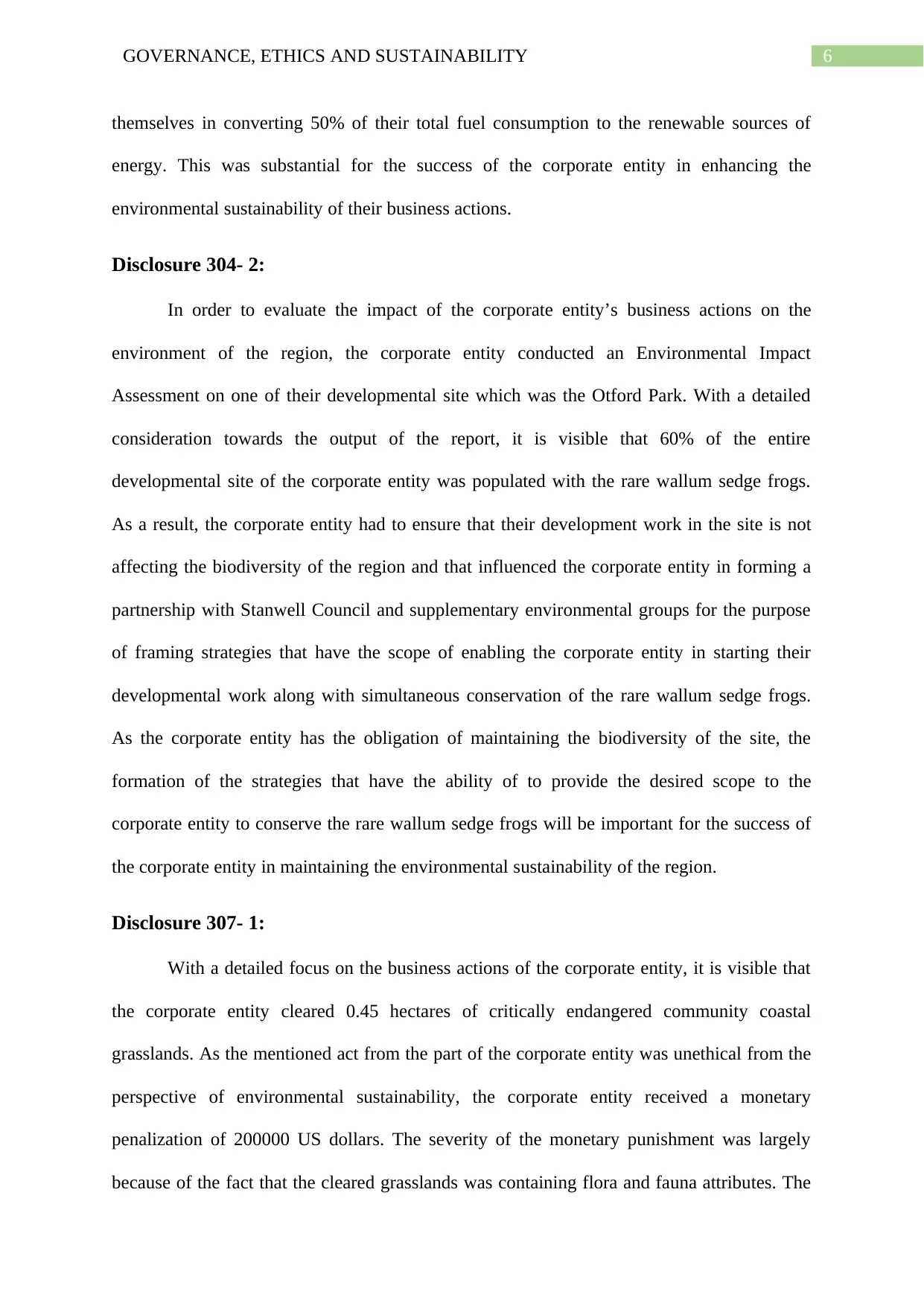
6GOVERNANCE, ETHICS AND SUSTAINABILITY
themselves in converting 50% of their total fuel consumption to the renewable sources of
energy. This was substantial for the success of the corporate entity in enhancing the
environmental sustainability of their business actions.
Disclosure 304- 2:
In order to evaluate the impact of the corporate entity’s business actions on the
environment of the region, the corporate entity conducted an Environmental Impact
Assessment on one of their developmental site which was the Otford Park. With a detailed
consideration towards the output of the report, it is visible that 60% of the entire
developmental site of the corporate entity was populated with the rare wallum sedge frogs.
As a result, the corporate entity had to ensure that their development work in the site is not
affecting the biodiversity of the region and that influenced the corporate entity in forming a
partnership with Stanwell Council and supplementary environmental groups for the purpose
of framing strategies that have the scope of enabling the corporate entity in starting their
developmental work along with simultaneous conservation of the rare wallum sedge frogs.
As the corporate entity has the obligation of maintaining the biodiversity of the site, the
formation of the strategies that have the ability of to provide the desired scope to the
corporate entity to conserve the rare wallum sedge frogs will be important for the success of
the corporate entity in maintaining the environmental sustainability of the region.
Disclosure 307- 1:
With a detailed focus on the business actions of the corporate entity, it is visible that
the corporate entity cleared 0.45 hectares of critically endangered community coastal
grasslands. As the mentioned act from the part of the corporate entity was unethical from the
perspective of environmental sustainability, the corporate entity received a monetary
penalization of 200000 US dollars. The severity of the monetary punishment was largely
because of the fact that the cleared grasslands was containing flora and fauna attributes. The
themselves in converting 50% of their total fuel consumption to the renewable sources of
energy. This was substantial for the success of the corporate entity in enhancing the
environmental sustainability of their business actions.
Disclosure 304- 2:
In order to evaluate the impact of the corporate entity’s business actions on the
environment of the region, the corporate entity conducted an Environmental Impact
Assessment on one of their developmental site which was the Otford Park. With a detailed
consideration towards the output of the report, it is visible that 60% of the entire
developmental site of the corporate entity was populated with the rare wallum sedge frogs.
As a result, the corporate entity had to ensure that their development work in the site is not
affecting the biodiversity of the region and that influenced the corporate entity in forming a
partnership with Stanwell Council and supplementary environmental groups for the purpose
of framing strategies that have the scope of enabling the corporate entity in starting their
developmental work along with simultaneous conservation of the rare wallum sedge frogs.
As the corporate entity has the obligation of maintaining the biodiversity of the site, the
formation of the strategies that have the ability of to provide the desired scope to the
corporate entity to conserve the rare wallum sedge frogs will be important for the success of
the corporate entity in maintaining the environmental sustainability of the region.
Disclosure 307- 1:
With a detailed focus on the business actions of the corporate entity, it is visible that
the corporate entity cleared 0.45 hectares of critically endangered community coastal
grasslands. As the mentioned act from the part of the corporate entity was unethical from the
perspective of environmental sustainability, the corporate entity received a monetary
penalization of 200000 US dollars. The severity of the monetary punishment was largely
because of the fact that the cleared grasslands was containing flora and fauna attributes. The
Paraphrase This Document
Need a fresh take? Get an instant paraphrase of this document with our AI Paraphraser
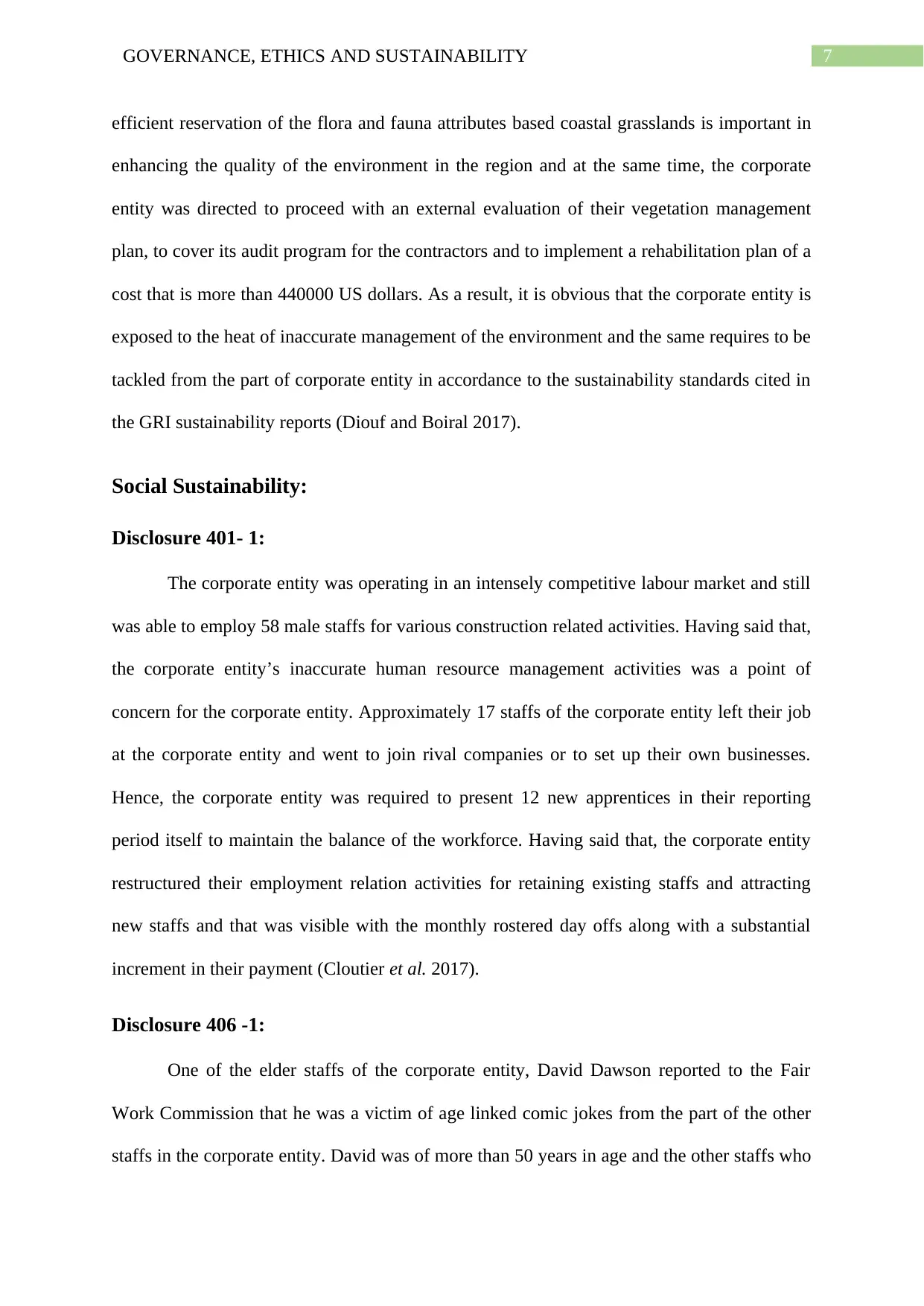
7GOVERNANCE, ETHICS AND SUSTAINABILITY
efficient reservation of the flora and fauna attributes based coastal grasslands is important in
enhancing the quality of the environment in the region and at the same time, the corporate
entity was directed to proceed with an external evaluation of their vegetation management
plan, to cover its audit program for the contractors and to implement a rehabilitation plan of a
cost that is more than 440000 US dollars. As a result, it is obvious that the corporate entity is
exposed to the heat of inaccurate management of the environment and the same requires to be
tackled from the part of corporate entity in accordance to the sustainability standards cited in
the GRI sustainability reports (Diouf and Boiral 2017).
Social Sustainability:
Disclosure 401- 1:
The corporate entity was operating in an intensely competitive labour market and still
was able to employ 58 male staffs for various construction related activities. Having said that,
the corporate entity’s inaccurate human resource management activities was a point of
concern for the corporate entity. Approximately 17 staffs of the corporate entity left their job
at the corporate entity and went to join rival companies or to set up their own businesses.
Hence, the corporate entity was required to present 12 new apprentices in their reporting
period itself to maintain the balance of the workforce. Having said that, the corporate entity
restructured their employment relation activities for retaining existing staffs and attracting
new staffs and that was visible with the monthly rostered day offs along with a substantial
increment in their payment (Cloutier et al. 2017).
Disclosure 406 -1:
One of the elder staffs of the corporate entity, David Dawson reported to the Fair
Work Commission that he was a victim of age linked comic jokes from the part of the other
staffs in the corporate entity. David was of more than 50 years in age and the other staffs who
efficient reservation of the flora and fauna attributes based coastal grasslands is important in
enhancing the quality of the environment in the region and at the same time, the corporate
entity was directed to proceed with an external evaluation of their vegetation management
plan, to cover its audit program for the contractors and to implement a rehabilitation plan of a
cost that is more than 440000 US dollars. As a result, it is obvious that the corporate entity is
exposed to the heat of inaccurate management of the environment and the same requires to be
tackled from the part of corporate entity in accordance to the sustainability standards cited in
the GRI sustainability reports (Diouf and Boiral 2017).
Social Sustainability:
Disclosure 401- 1:
The corporate entity was operating in an intensely competitive labour market and still
was able to employ 58 male staffs for various construction related activities. Having said that,
the corporate entity’s inaccurate human resource management activities was a point of
concern for the corporate entity. Approximately 17 staffs of the corporate entity left their job
at the corporate entity and went to join rival companies or to set up their own businesses.
Hence, the corporate entity was required to present 12 new apprentices in their reporting
period itself to maintain the balance of the workforce. Having said that, the corporate entity
restructured their employment relation activities for retaining existing staffs and attracting
new staffs and that was visible with the monthly rostered day offs along with a substantial
increment in their payment (Cloutier et al. 2017).
Disclosure 406 -1:
One of the elder staffs of the corporate entity, David Dawson reported to the Fair
Work Commission that he was a victim of age linked comic jokes from the part of the other
staffs in the corporate entity. David was of more than 50 years in age and the other staffs who
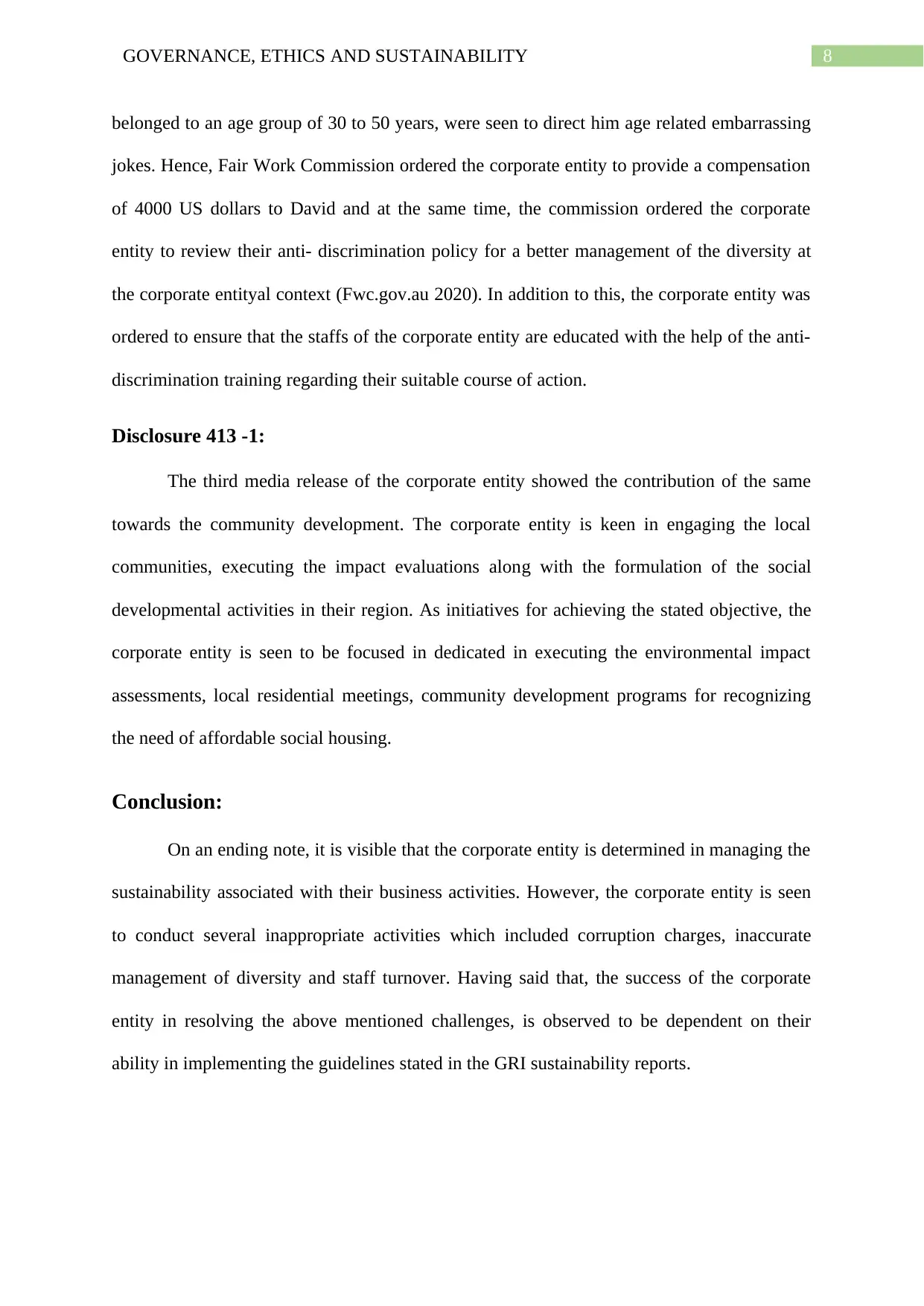
8GOVERNANCE, ETHICS AND SUSTAINABILITY
belonged to an age group of 30 to 50 years, were seen to direct him age related embarrassing
jokes. Hence, Fair Work Commission ordered the corporate entity to provide a compensation
of 4000 US dollars to David and at the same time, the commission ordered the corporate
entity to review their anti- discrimination policy for a better management of the diversity at
the corporate entityal context (Fwc.gov.au 2020). In addition to this, the corporate entity was
ordered to ensure that the staffs of the corporate entity are educated with the help of the anti-
discrimination training regarding their suitable course of action.
Disclosure 413 -1:
The third media release of the corporate entity showed the contribution of the same
towards the community development. The corporate entity is keen in engaging the local
communities, executing the impact evaluations along with the formulation of the social
developmental activities in their region. As initiatives for achieving the stated objective, the
corporate entity is seen to be focused in dedicated in executing the environmental impact
assessments, local residential meetings, community development programs for recognizing
the need of affordable social housing.
Conclusion:
On an ending note, it is visible that the corporate entity is determined in managing the
sustainability associated with their business activities. However, the corporate entity is seen
to conduct several inappropriate activities which included corruption charges, inaccurate
management of diversity and staff turnover. Having said that, the success of the corporate
entity in resolving the above mentioned challenges, is observed to be dependent on their
ability in implementing the guidelines stated in the GRI sustainability reports.
belonged to an age group of 30 to 50 years, were seen to direct him age related embarrassing
jokes. Hence, Fair Work Commission ordered the corporate entity to provide a compensation
of 4000 US dollars to David and at the same time, the commission ordered the corporate
entity to review their anti- discrimination policy for a better management of the diversity at
the corporate entityal context (Fwc.gov.au 2020). In addition to this, the corporate entity was
ordered to ensure that the staffs of the corporate entity are educated with the help of the anti-
discrimination training regarding their suitable course of action.
Disclosure 413 -1:
The third media release of the corporate entity showed the contribution of the same
towards the community development. The corporate entity is keen in engaging the local
communities, executing the impact evaluations along with the formulation of the social
developmental activities in their region. As initiatives for achieving the stated objective, the
corporate entity is seen to be focused in dedicated in executing the environmental impact
assessments, local residential meetings, community development programs for recognizing
the need of affordable social housing.
Conclusion:
On an ending note, it is visible that the corporate entity is determined in managing the
sustainability associated with their business activities. However, the corporate entity is seen
to conduct several inappropriate activities which included corruption charges, inaccurate
management of diversity and staff turnover. Having said that, the success of the corporate
entity in resolving the above mentioned challenges, is observed to be dependent on their
ability in implementing the guidelines stated in the GRI sustainability reports.
⊘ This is a preview!⊘
Do you want full access?
Subscribe today to unlock all pages.

Trusted by 1+ million students worldwide
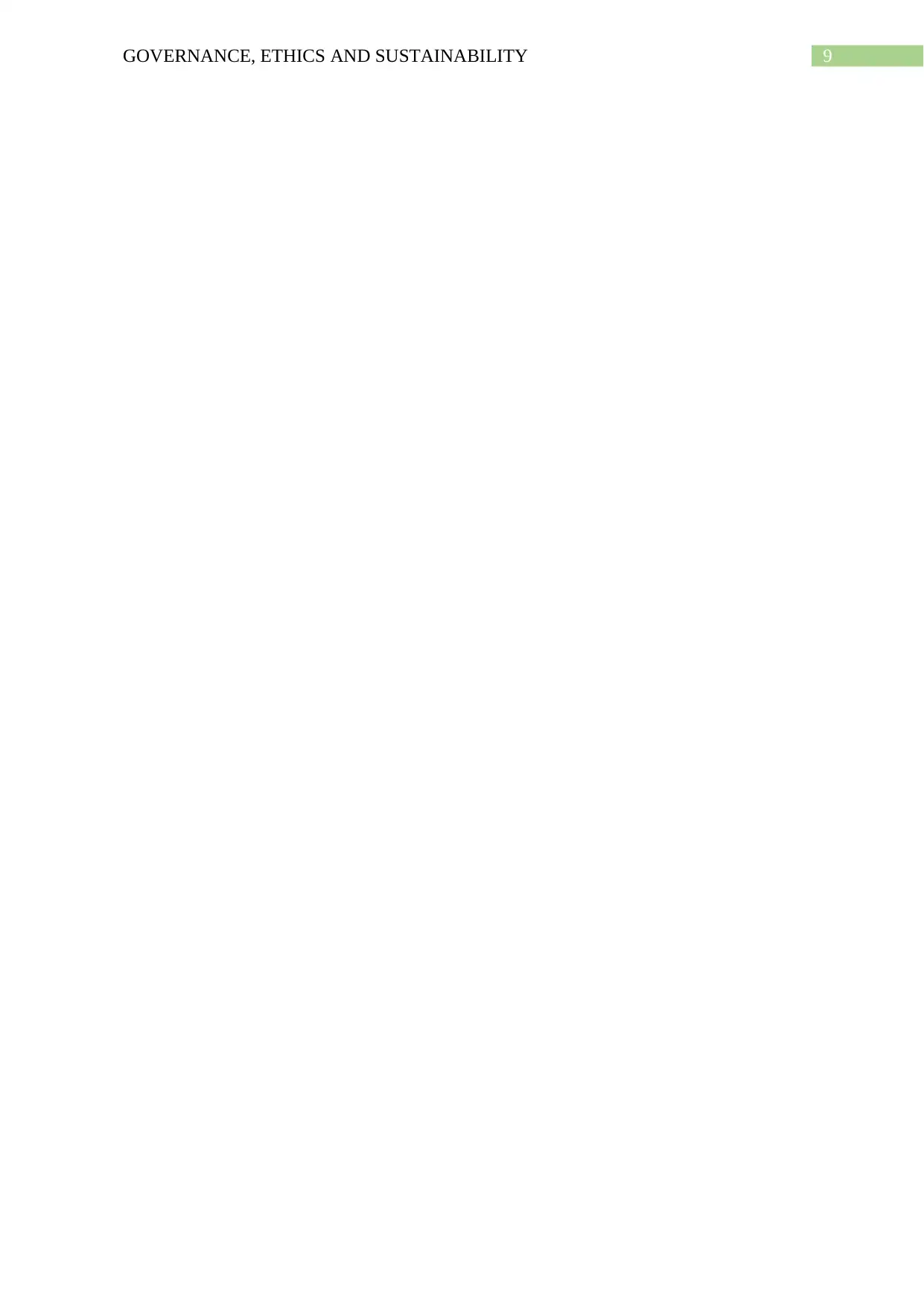
9GOVERNANCE, ETHICS AND SUSTAINABILITY
Paraphrase This Document
Need a fresh take? Get an instant paraphrase of this document with our AI Paraphraser
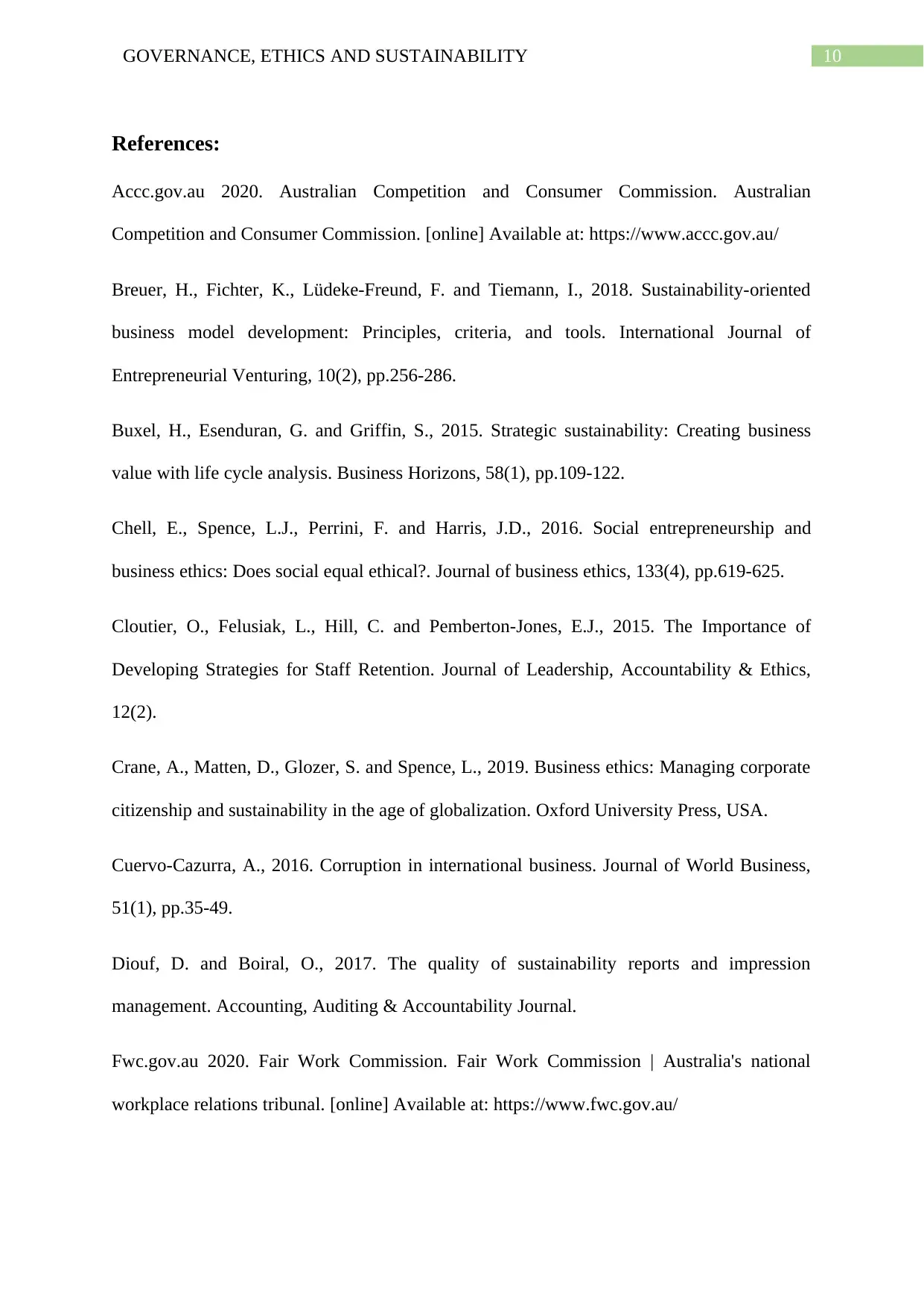
10GOVERNANCE, ETHICS AND SUSTAINABILITY
References:
Accc.gov.au 2020. Australian Competition and Consumer Commission. Australian
Competition and Consumer Commission. [online] Available at: https://www.accc.gov.au/
Breuer, H., Fichter, K., Lüdeke-Freund, F. and Tiemann, I., 2018. Sustainability-oriented
business model development: Principles, criteria, and tools. International Journal of
Entrepreneurial Venturing, 10(2), pp.256-286.
Buxel, H., Esenduran, G. and Griffin, S., 2015. Strategic sustainability: Creating business
value with life cycle analysis. Business Horizons, 58(1), pp.109-122.
Chell, E., Spence, L.J., Perrini, F. and Harris, J.D., 2016. Social entrepreneurship and
business ethics: Does social equal ethical?. Journal of business ethics, 133(4), pp.619-625.
Cloutier, O., Felusiak, L., Hill, C. and Pemberton-Jones, E.J., 2015. The Importance of
Developing Strategies for Staff Retention. Journal of Leadership, Accountability & Ethics,
12(2).
Crane, A., Matten, D., Glozer, S. and Spence, L., 2019. Business ethics: Managing corporate
citizenship and sustainability in the age of globalization. Oxford University Press, USA.
Cuervo-Cazurra, A., 2016. Corruption in international business. Journal of World Business,
51(1), pp.35-49.
Diouf, D. and Boiral, O., 2017. The quality of sustainability reports and impression
management. Accounting, Auditing & Accountability Journal.
Fwc.gov.au 2020. Fair Work Commission. Fair Work Commission | Australia's national
workplace relations tribunal. [online] Available at: https://www.fwc.gov.au/
References:
Accc.gov.au 2020. Australian Competition and Consumer Commission. Australian
Competition and Consumer Commission. [online] Available at: https://www.accc.gov.au/
Breuer, H., Fichter, K., Lüdeke-Freund, F. and Tiemann, I., 2018. Sustainability-oriented
business model development: Principles, criteria, and tools. International Journal of
Entrepreneurial Venturing, 10(2), pp.256-286.
Buxel, H., Esenduran, G. and Griffin, S., 2015. Strategic sustainability: Creating business
value with life cycle analysis. Business Horizons, 58(1), pp.109-122.
Chell, E., Spence, L.J., Perrini, F. and Harris, J.D., 2016. Social entrepreneurship and
business ethics: Does social equal ethical?. Journal of business ethics, 133(4), pp.619-625.
Cloutier, O., Felusiak, L., Hill, C. and Pemberton-Jones, E.J., 2015. The Importance of
Developing Strategies for Staff Retention. Journal of Leadership, Accountability & Ethics,
12(2).
Crane, A., Matten, D., Glozer, S. and Spence, L., 2019. Business ethics: Managing corporate
citizenship and sustainability in the age of globalization. Oxford University Press, USA.
Cuervo-Cazurra, A., 2016. Corruption in international business. Journal of World Business,
51(1), pp.35-49.
Diouf, D. and Boiral, O., 2017. The quality of sustainability reports and impression
management. Accounting, Auditing & Accountability Journal.
Fwc.gov.au 2020. Fair Work Commission. Fair Work Commission | Australia's national
workplace relations tribunal. [online] Available at: https://www.fwc.gov.au/
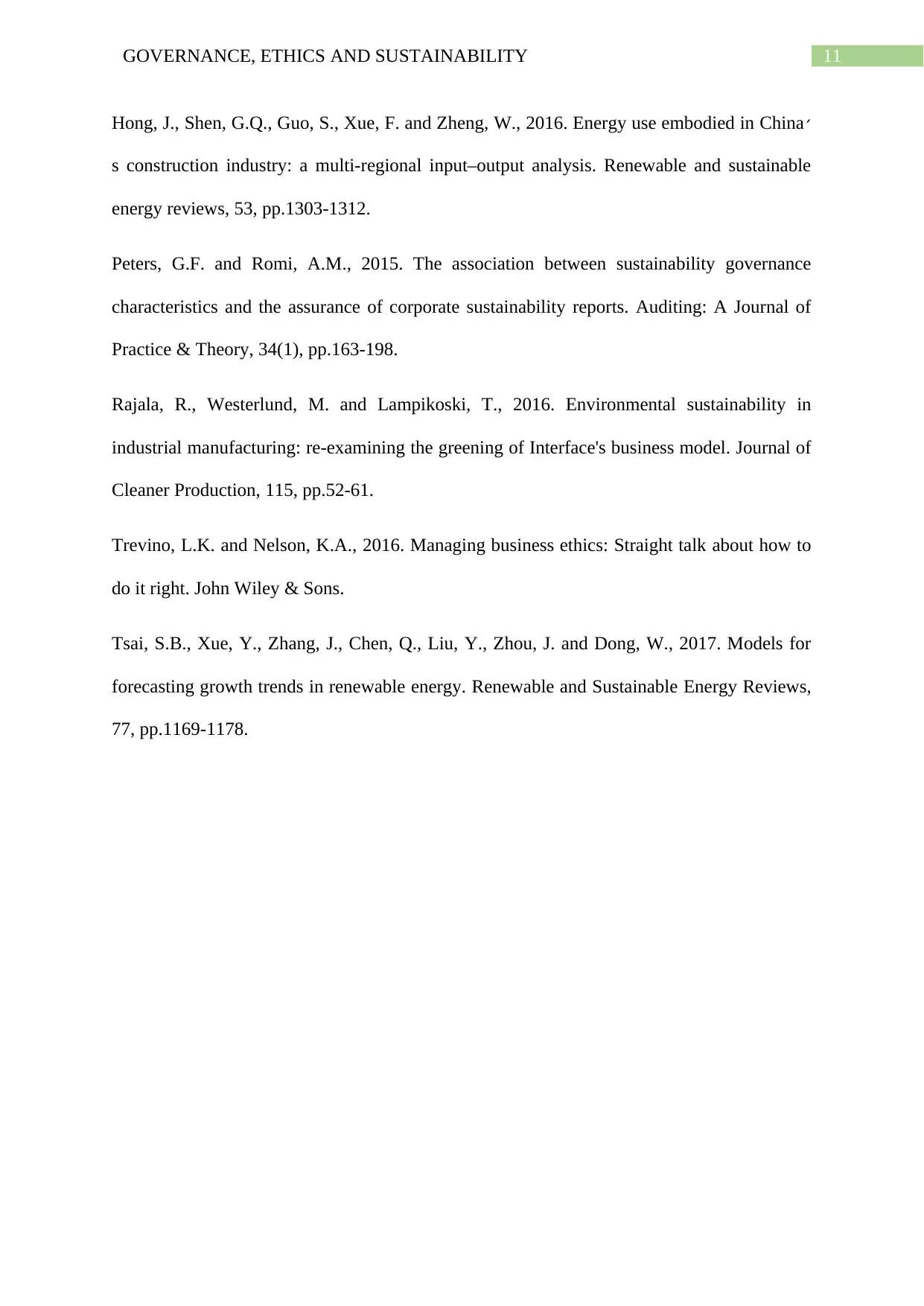
11GOVERNANCE, ETHICS AND SUSTAINABILITY
Hong, J., Shen, G.Q., Guo, S., Xue, F. and Zheng, W., 2016. Energy use embodied in China׳
s construction industry: a multi-regional input–output analysis. Renewable and sustainable
energy reviews, 53, pp.1303-1312.
Peters, G.F. and Romi, A.M., 2015. The association between sustainability governance
characteristics and the assurance of corporate sustainability reports. Auditing: A Journal of
Practice & Theory, 34(1), pp.163-198.
Rajala, R., Westerlund, M. and Lampikoski, T., 2016. Environmental sustainability in
industrial manufacturing: re-examining the greening of Interface's business model. Journal of
Cleaner Production, 115, pp.52-61.
Trevino, L.K. and Nelson, K.A., 2016. Managing business ethics: Straight talk about how to
do it right. John Wiley & Sons.
Tsai, S.B., Xue, Y., Zhang, J., Chen, Q., Liu, Y., Zhou, J. and Dong, W., 2017. Models for
forecasting growth trends in renewable energy. Renewable and Sustainable Energy Reviews,
77, pp.1169-1178.
Hong, J., Shen, G.Q., Guo, S., Xue, F. and Zheng, W., 2016. Energy use embodied in China׳
s construction industry: a multi-regional input–output analysis. Renewable and sustainable
energy reviews, 53, pp.1303-1312.
Peters, G.F. and Romi, A.M., 2015. The association between sustainability governance
characteristics and the assurance of corporate sustainability reports. Auditing: A Journal of
Practice & Theory, 34(1), pp.163-198.
Rajala, R., Westerlund, M. and Lampikoski, T., 2016. Environmental sustainability in
industrial manufacturing: re-examining the greening of Interface's business model. Journal of
Cleaner Production, 115, pp.52-61.
Trevino, L.K. and Nelson, K.A., 2016. Managing business ethics: Straight talk about how to
do it right. John Wiley & Sons.
Tsai, S.B., Xue, Y., Zhang, J., Chen, Q., Liu, Y., Zhou, J. and Dong, W., 2017. Models for
forecasting growth trends in renewable energy. Renewable and Sustainable Energy Reviews,
77, pp.1169-1178.
⊘ This is a preview!⊘
Do you want full access?
Subscribe today to unlock all pages.

Trusted by 1+ million students worldwide
1 out of 12
Related Documents
Your All-in-One AI-Powered Toolkit for Academic Success.
+13062052269
info@desklib.com
Available 24*7 on WhatsApp / Email
![[object Object]](/_next/static/media/star-bottom.7253800d.svg)
Unlock your academic potential
Copyright © 2020–2025 A2Z Services. All Rights Reserved. Developed and managed by ZUCOL.





